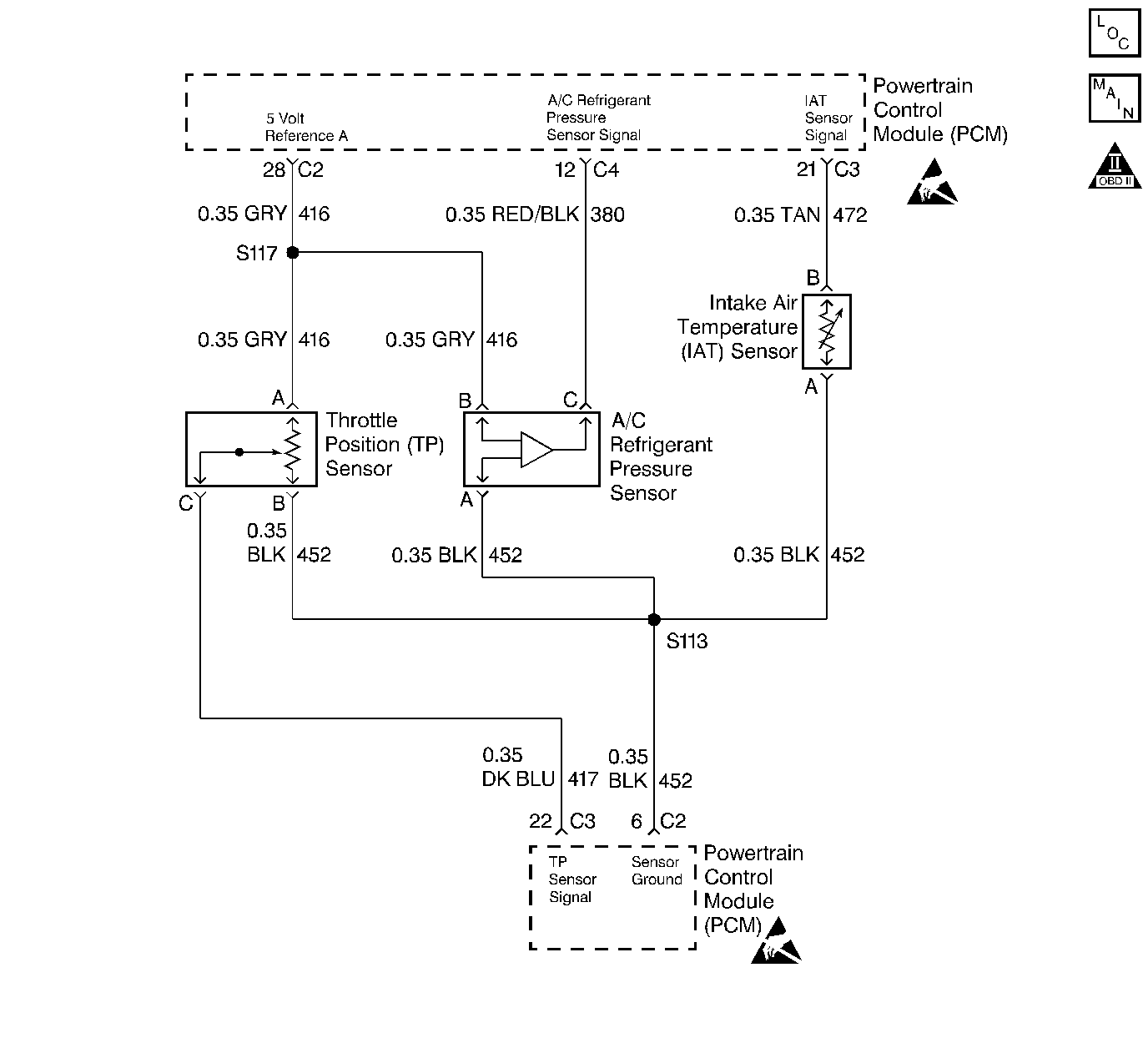
Circuit Description
The Throttle Position (TP) sensor is a potentiometer. The TP sensor is mounted to the right side of the throttle body. The TP sensor provides a voltage signal that changes relative to throttle blade angle. This signal voltage is one of the most important inputs used by the PCM. The TP sensor has a 5.0 volt reference, a ground and a signal circuit.
TP sensor Signal voltage should be about 0.6 volt at idle. The TP sensor voltage should increase to above 4.0 volts at wide open throttle (WOT).
When the PCM senses a signal voltage lower than the normal operating range of the sensor, this DTC will set.
Conditions for Setting the DTC
TP sensor voltage is less than 0.2 volts for 0.3 second.
Action Taken When the DTC Sets
| • | The DTC will be stored in the PCM memory when the diagnostic runs and fails. |
| • | The Malfunction Indicator Lamp (MIL) will not illuminate. |
| • | The PCM will record operating conditions at the time the diagnostic fails. This information will be stored in Failure Records. |
Conditions for Clearing the MIL/DTC
| • | A history DTC will clear after 40 consecutive warm-up cycles, if no failures are reported by this or any other non-emission related diagnostic. |
| • | A last test failed (Current DTC) will clear when the diagnostic runs and does not fail. |
| • | PCM battery voltage is interrupted. |
| • | Using a scan tool. |
Diagnostic Aids
An intermittent DTC can be caused by electromagnetic interference (EMI). Inspect related circuits for being too close to secondary ignition wires and the alternator.
For intermittents, refer to Symptoms .
Test Description
Number(s) below refer to step numbers on the diagnostic table.
-
If DTC P0122 failed this ignition, indicates a hard failure is present. When a hard failure is present, both the hard and intermittent DTCs will set. The engine must be operating longer than 30 seconds before checking if the DTC set.
-
When moving related connectors, visually/physically inspect connectors for the following:
-
When moving related wiring harnesses, visually/physically inspect wiring for the following:
-
Using Freeze Frame and/or Failure Records data may aid in locating an intermittent condition. If the DTC cannot be duplicated, the information included in the Freeze Frame and/or Failure Records data can be useful in determining how many miles since the DTC set. The Fail Counter and Pass Counter can also be used to determine how many ignition cycles the diagnostic reported a pass and/or a fail. Operate vehicle within the same freeze frame conditions (RPM, load, vehicle speed, temperature etc.) that were noted. This will isolate when the DTC failed.
| • | Poor mating of the connector halves or a terminal not fully seated in the connector body (backed out). |
| • | Improperly formed or damaged terminals. All connector terminals in the related circuits should be carefully reformed or replaced to insure proper contact tension. |
| • | Poor terminal to wire connection. Inspect for poor crimps, crimping over wire insulation rather than the wire. |
| • | Dirt or corrosion on terminals. Inspect connector seals for being there and for being damaged. |
| • | Wire insulation that is rubbed through, causing an intermittent short. |
| • | Wiring broken inside the insulation. |
Step | Action | Value(s) | Yes | No |
|---|---|---|---|---|
1 | Was the Powertrain On-Board Diagnostic (OBD) System Check performed? | -- | ||
Did DTC P0122 fail this ignition cycle? | -- | Go to DTC P0122 Throttle Position (TP) Sensor Circuit Low Voltage | ||
Does sensor value change abruptly while a related connector is being moved? | -- | |||
Using a scan tool, observe affected sensor value while moving related wiring harnesses. Does sensor value change abruptly while moving related electrical harnesses? | -- | |||
Does the scan tool indicate that this diagnostic failed this ignition? | -- | Go to Diagnostic Aids | ||
6 | Repair the damaged connectors/terminals following repair procedures in Electrical Diagnosis (8A Cell 5). Is the action complete? | -- | -- | |
7 | Repair the faulty wiring following repair procedures in Electrical Diagnosis (8A Cell 5). Is the action complete? | -- | -- | |
8 |
Is the action complete? | -- | -- | |
9 |
Does the scan tool indicate that this test ran and passed? | -- | ||
10 | Using the scan tool, select Capture Info, Review Info. Are any DTCs displayed that have not been diagnosed? | -- | Go to the applicable DTC table | System OK |
